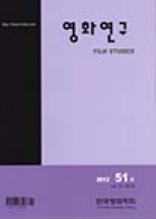- 영문명
- A Study on Retrospective Images and Nostalgia as a Hallucination Symbol Shown in 'Sunny'
- 발행기관
- 한국영화학회
- 저자명
- 최병근
- 간행물 정보
- 『영화연구』제50호, 543~562쪽, 전체 20쪽
- 주제분류
- 예술체육 > 예술일반
- 파일형태
- 발행일자
- 2011.12.31
5,200원
구매일시로부터 72시간 이내에 다운로드 가능합니다.
이 학술논문 정보는 (주)교보문고와 각 발행기관 사이에 저작물 이용 계약이 체결된 것으로, 교보문고를 통해 제공되고 있습니다.

국문 초록
영문 초록
The prospects of occupancy rate for Korean movies were not optimistic in the first half of 2011 since there were some newly released Hollywood blockbusters such as (2011), (2011), (2011) and (2011). However, the biggest box office hit in the first half of 2011 in South Korea was directed by Kang Hyung-cheol. There were no actors or actresses with ticket selling power in this movie. Furthermore, this movie had a disadvantage of designating a large number of characters and its subsequent weakness of a lack of audience's engagement. No one expected that it stood against Hollywood blockbusters. Regarding the reasons for 's box office hit, many people concerned with the movies mentioned that it led the audience to feel the creation style with a sense of noticeable entertainment and emotional identification and it aroused the code of nostalgia penetrating the sensibility of the audience. Today the codes stirring up the past in popular cultures provided romantic nostalgia, which created a trend. As shown recently in a TV program such as or in 'C'est si bon' Fever, the cultural codes belonging to the past could embrace previous generations and endow the audience with a sense of being touched. It could be explained in terms of collective arousal of the memories that had been shared by people in the past, but the reason for influencing the generations who did not experience the times was due to the sociological representation, such as nostalgia with a signifier of the past. In the movie that aroused the past through 'the memory search' of women in their forties, the past enumerated popular cultures in the 1980s and these functioned as an exhibition space. Namely, the images of retrospection closely related to the popular cultures at the time gave the audience an opportunity to enjoy 'cultural memories.' In this way, the method of calling in arousal by projecting specific time period into materialistic images has been one of the esthetic strategies found in the movies of nostalgia. It could be assumed that such a strategy interacted with the desire of people and contributed to the success of . Therefore, this study was aimed to interpret the keyword of nostalgia embraced by people through the images of retrospection and the medium method adopted by . It would be closely related to the specific formalistic structures established by the movies of nostalgia. Besides, it would help us have a better understanding of the movies of nostalgia deeply established as a commercial genre along with the acceleration of modernization.
목차
1. 서론
2. 과거의 기억 - 미화된 판타지 혹은 표면화된 이미지
3. 과거를 투사하는 공간 이미지
4. ‘과거’를 불러오는 기표와 그 표상
5. 결론
해당간행물 수록 논문
- 일제 강점 말기와 유신 정권 시기의 국책선전영화 비교 연구
- 유신체제기 한국영화 <증언>(1974)의 영화적 특징과 시대적 특수성
- 조선영화 태동기의 일꾼 이구영의 영화인생론
- 쇼트/역쇼트에 대한 지각심리학적 접근
- 영화제작에 사용되는 모션과 페이셜 캡쳐 연구
- 열린 아시아, 닫힌 민족주의
- 리아 타지리의 영화 <역사와 기억>에 대한 연구
- 일상적 현실에 대한 풍자와 비판, 창작수법의 혁신, 체코슬로바키아 영화(1963-1968)
- 인터랙티브 알고리즘에 기반을 둔 다양한 영상 실험과 미학
- 부산영상산업 발전방향 타당성 연구
- ‘한국영화 르네상스’(1997~2006)의 동역학에 대한 연구
- 다큐멘터리영화의 관객소통 방식 연구
- 경북 영화산업 활성화 방안
- <잔 다르크의 열정>의 표현주의적 성격에 대하여
- 남자, 몸, 폭력 그리고 이산(離散)정체성의 정치학
- 대안적인 다큐멘터리 스타일: 장르 컨벤션의 활용
- 아리스토텔레스의 ‘시학’을 통해서 본 영화의 대중성 연구
- 관계론적 입장에서 바라본 탈 중심 공간의 시각이미지 표현 방법 연구
- <써니>를 통해 본 복고 이미지와 환각적 기호로서의 향수에 관한 연구
참고문헌
관련논문
예술체육 > 예술일반분야 BEST
- 생성형 AI 도구와 디자이너의 협업 프로세스 개발 - 이미지를 통한 아이디어 확산에서 고해상도 렌더링까지
- 영화 [올드보이]와 소포클레스 「오이디푸스 왕」의 상동성 연구
- ‘일과 삶의 균형(Work-Life Balance)’ 척도 개발을 위한 연구
최근 이용한 논문
교보eBook 첫 방문을 환영 합니다!

신규가입 혜택 지급이 완료 되었습니다.
바로 사용 가능한 교보e캐시 1,000원 (유효기간 7일)
지금 바로 교보eBook의 다양한 콘텐츠를 이용해 보세요!



